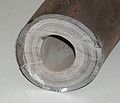Formic acid (from Latin formica 'ant'), systematically named methanoic acid, is the simplest carboxylic acid, and has the chemical formula HCOOH and structure...
38 KB (3,910 words) - 23:31, 9 July 2024
organic acids. A few common examples include: Lactic acid Acetic acid Formic acid Citric acid Oxalic acid Uric acid Malic acid Tartaric acid Butyric acid Folic...
10 KB (1,203 words) - 08:21, 1 July 2024
Formate (redirect from Formic acid esters)
methanoate) is the conjugate base of formic acid. Formate is an anion (HCO−2) or its derivatives such as ester of formic acid. The salts and esters are generally...
6 KB (514 words) - 14:44, 7 May 2024
Sodium formate (redirect from Formic acid sodium salt)
Sodium formate, HCOONa, is the sodium salt of formic acid, HCOOH. It usually appears as a white deliquescent powder. For commercial use, sodium formate...
10 KB (1,044 words) - 21:41, 12 March 2024
weaker acids (the pKa of formic acid is 3.75 whereas acetic acid, with a methyl substituent, has a pKa of 4.76) Deprotonation of carboxylic acids gives...
23 KB (2,176 words) - 10:55, 11 July 2024
O-H. Acetic acid (CH3COOH) Citric acid (C6H8O7) Formic acid (HCOOH) Gluconic acid HOCH2-(CHOH)4-COOH Lactic acid (CH3-CHOH-COOH) Oxalic acid (HOOC-COOH)...
47 KB (5,956 words) - 18:26, 8 July 2024
formic acid (HCOOH). Formic anhydride can be obtained by reaction of formyl fluoride with excess sodium formate and a catalytic amount of formic acid...
4 KB (435 words) - 05:32, 29 June 2023
Formic acid fuel cells (direct formic acid fuel cells or DFAFCs) are a subcategory of direct liquid-feed fuel cells (DLFCs), in which the liquid fuel is...
17 KB (1,985 words) - 14:45, 9 December 2023
up formic in Wiktionary, the free dictionary. Formic is an adjective describing ants, from the Latin formica. Formic may also refer to: Formic acid, a...
326 bytes (81 words) - 08:13, 9 February 2016
from at least the third century BC. Acetic acid is the second simplest carboxylic acid (after formic acid). It is an important chemical reagent and industrial...
62 KB (6,567 words) - 04:57, 1 July 2024
Ester (redirect from Carboxylic acid ester)
esters of formic acid. For example, butyl acetate (systematically butyl ethanoate), derived from butanol and acetic acid (systematically ethanoic acid) would...
42 KB (4,410 words) - 22:49, 4 July 2024
This page provides supplementary chemical data on formic acid. The handling of this chemical may incur notable safety precautions. It is highly recommend...
9 KB (215 words) - 13:41, 9 November 2023
Methyl formate (redirect from Methyl ester of formic acid)
Methyl formate, also called methyl methanoate, is the methyl ester of formic acid. The simplest example of a carboxylate ester, it is a colorless liquid...
6 KB (364 words) - 20:04, 27 April 2024
Descaling agent (section Acids used)
agents include acetic acid, citric acid, glycolic acid, formic acid, lactic acid, phosphoric acid, sulfamic acid and hydrochloric acid. The calcium salts...
4 KB (468 words) - 11:08, 9 March 2024
of carboxylic acids is their Brønsted acidity. The simplest carboxylic acid, formic acid (HC(=O)−OH), is a moderately strong organic acid with a pKa of...
8 KB (906 words) - 21:15, 15 March 2024
Amino acids are organic compounds that contain both amino and carboxylic acid functional groups. Although over 500 amino acids exist in nature, by far...
97 KB (10,074 words) - 18:14, 1 July 2024
Tartaric acid is a white, crystalline organic acid that occurs naturally in many fruits, most notably in grapes but also in tamarinds, bananas, avocados...
26 KB (2,286 words) - 22:09, 10 July 2024
Hydrogen cyanide (redirect from Formic anammonide)
Hydrogen cyanide (formerly known as prussic acid) is a chemical compound with the formula HCN and structural formula H−C≡N. It is a highly toxic and flammable...
46 KB (4,591 words) - 13:51, 1 July 2024
mineral acids form hydrogen ions and the conjugate base when dissolved in water. Commonly used mineral acids are sulfuric acid (H2SO4), hydrochloric acid (HCl)...
2 KB (238 words) - 19:40, 27 April 2024
Phosphoric acid (orthophosphoric acid, monophosphoric acid or phosphoric(V) acid) is a colorless, odorless phosphorus-containing solid, and inorganic...
27 KB (2,338 words) - 06:13, 4 July 2024
a fatty acid is a carboxylic acid with an aliphatic chain, which is either saturated or unsaturated. Most naturally occurring fatty acids have an unbranched...
54 KB (4,976 words) - 13:45, 25 June 2024
derivative). Chloroformic acid is also structurally related to formic acid, in a way that the non-acidic hydrogen of formic acid is replaced by chlorine...
4 KB (229 words) - 16:12, 19 April 2024
Monosodium glutamate (redirect from Monosodium glutamatic acid)
sodium salt of glutamic acid. MSG is found naturally in some foods including tomatoes and cheese in this glutamic acid form. MSG is used in cooking as...
42 KB (4,420 words) - 01:41, 26 June 2024
acetic formic anhydride (see below), are known, whereby reaction occurs between two different carboxylic acids. Nomenclature of unsymmetrical acid anhydrides...
13 KB (1,476 words) - 17:04, 27 May 2024
Propionic acid has physical properties intermediate between those of the smaller carboxylic acids, formic and acetic acids, and the larger fatty acids. It is...
34 KB (3,206 words) - 08:29, 13 July 2024
Lipoic acid (LA), also known as α-lipoic acid, alpha-lipoic acid (ALA) and thioctic acid, is an organosulfur compound derived from caprylic acid (octanoic...
48 KB (4,958 words) - 20:48, 4 July 2024
(passive anting). The insects secrete liquids containing chemicals such as formic acid, which can act as an insecticide, miticide, fungicide, or bactericide...
11 KB (1,419 words) - 02:12, 18 May 2024
various lactic acid bacteria. It has a long shelf life and a distinctive sour flavor, both of which result from the lactic acid formed when the bacteria...
33 KB (3,346 words) - 02:17, 13 July 2024
cyanohydrin derived from formaldehyde. Some of today's glycolic acids are formic acid-free. Glycolic acid can be isolated from natural sources, such as sugarcane...
13 KB (1,153 words) - 18:14, 19 May 2024
converted into acetic acid by acetic acid-forming bacteria (Acetobacter species), yielding cider vinegar. Acetic acid and malic acid combine to give this...
7 KB (808 words) - 02:10, 18 April 2024
























